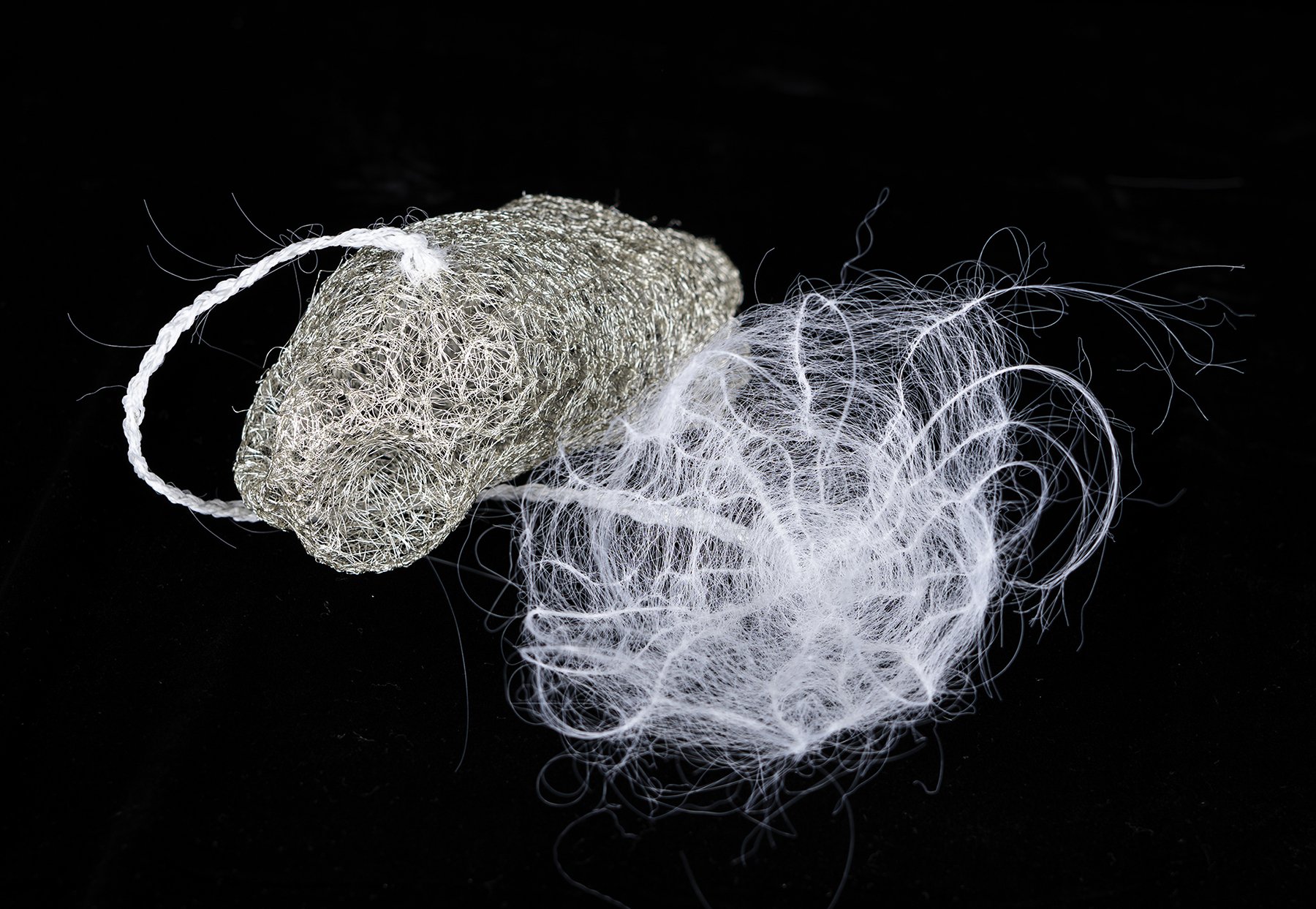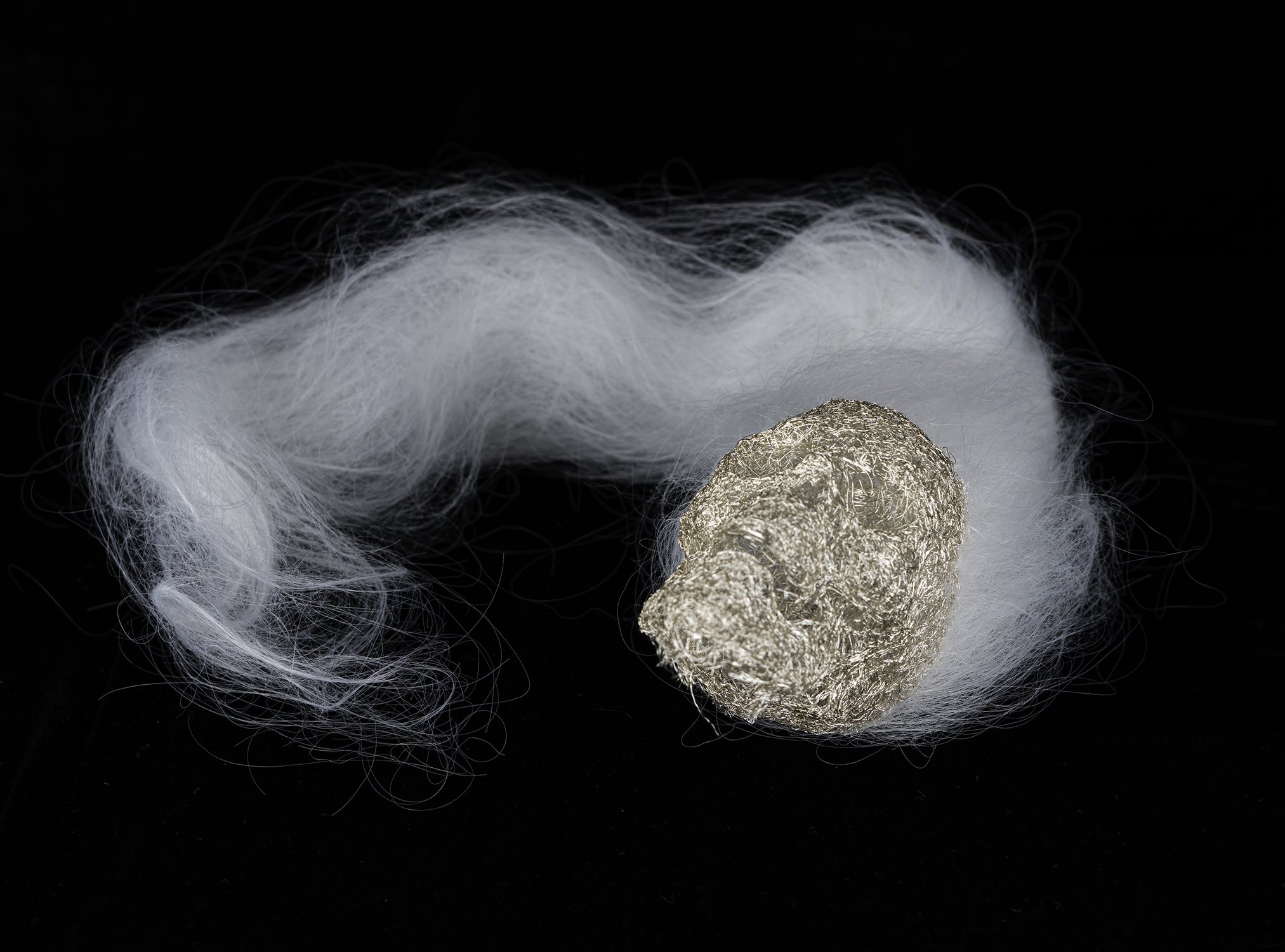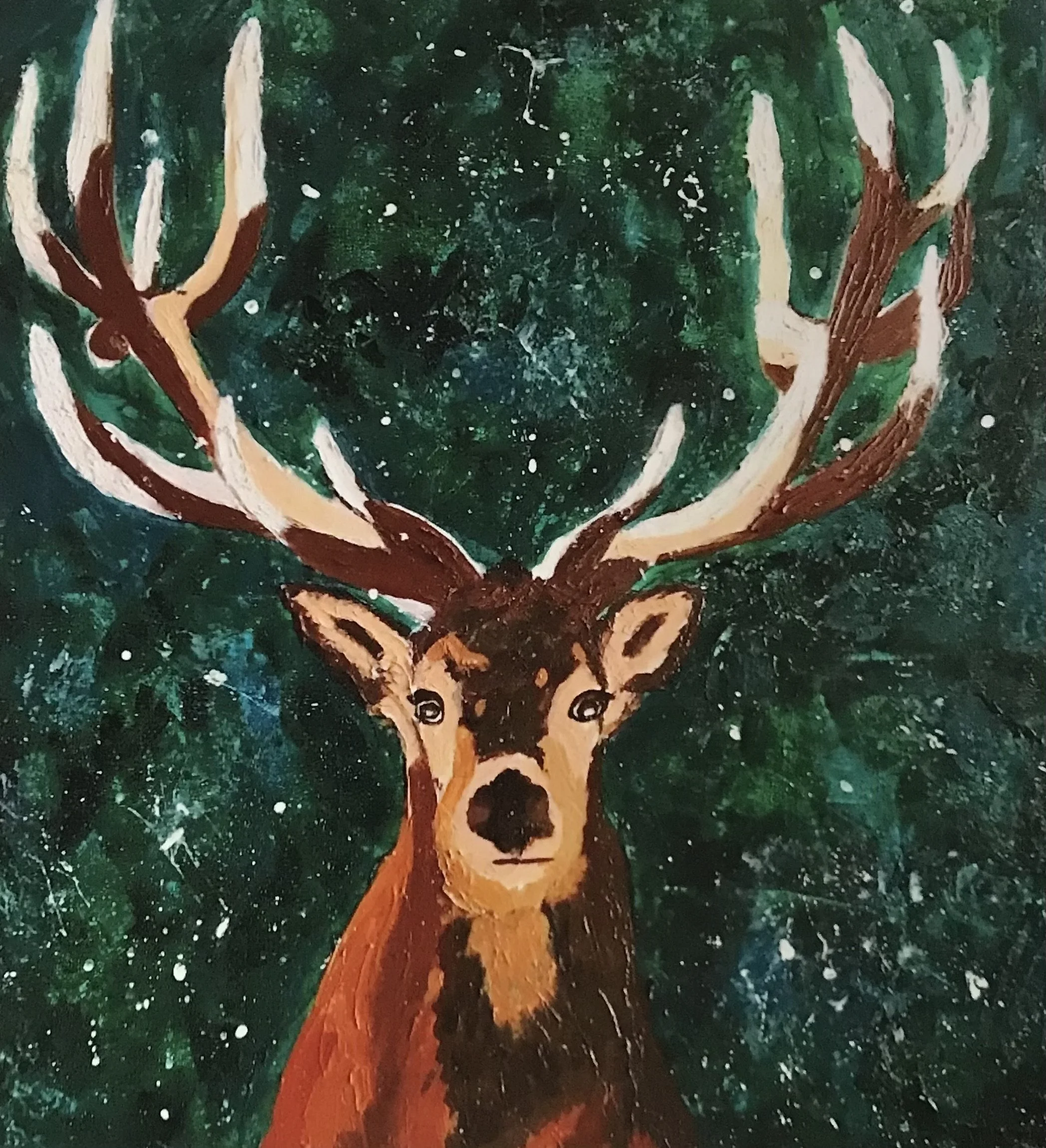Interview with Aomi Kikuchi
Buddha preached that “By understanding and accepting the impermanence and insubstantiality of this world, we can control our cravings and alleviate suffering."I am inspired by his philosophy and the Japanese aesthetics of Wabi-Sabi (imperfection) and mono no a-wa-re (compassionate heart).
Through my artwork, I convey that compassion is a meaningful solution to alleviating cravings. I focus on personal desires and suffering, and on people and things that are forced to suffer in order to satisfy the greed of others. Fear and disgust are also causes of suffering. I work to help people let go of negative emotions by finding new perspectives and turning negative emotions into positive ones.
I am a multidisciplinary artist primarily focused on "Art Povera", an anti-hierarchical approach. I incorporate everyday goods and humble materials into 2D/3D works such as sculptures, clothing, and objects. By utilizing materials that were previously discarded or thought to have no value, and infusing them with new perspectives and meaning, we can advance the idea that anything in daily life can be used as material for art. This idea leads to creating works with less environmental impact.
While studying academic art, I also followed my own curiosity and learned craft techniques. They include dressmaking, traditional kimono dyeing techniques, dyeing in general, ceramics, ceramic painting, Japanese embroidery, knitting, and Urushi-lacquer. In addition to continuously examining the difference between art and craft and the potential of craft as an artistic expression, I would like to pursue innovative art without being bound by preconceived notions.
How have your experiences at Kyoto University of Art & Design and Pratt Institute shaped your approach to textile art, and what are some key lessons you've carried forward from your time there?
I took a dyeing course at Kyoto University of Art and Design. Until then, I was working on Yuzen dyeing, a traditional Japanese kimono dyeing technique, under the guidance of several skilled craftsmen. At the university, I learned practical dyeing techniques such as wax, pattern dyeing, tie-dying, screen printing with general education, art history, and aesthetics. I gained other artistic skills such as woodworking, metalworking, and bookbinding. All of these experiences became my foundation then I further developed them to my own contemporary art at Pratt.
At Pratt, I focused more on art history, aesthetics, and professional activities as an artist than technical studies. Before Pratt, I learned a lot of traditional craft techniques. I do not think that learning crafts was meaningless in creating contemporary art. Even in mainstream art such as oil paintings and marble sculptures, it is impossible to create without the basic knowledge of materials and techniques. I think craft techniques are an archive of information such as the characteristics of various materials and optimal processing methods that craftsmen have cultivated over many years. Pratt was an important place for learning how to build my own world more freely based on the experiences of learning craft.
In your work, you often reference the Japanese aesthetics of 'Wabi-sabi' and 'Mono-no-aware'. How do these philosophies influence the conceptual and physical aspects of your creations?
The aesthetics of “Wabi-sabi” and “Mono-no-aware” are deeply connected to Shinto, Japan's primitive religion, and Buddhism, which came from China. Shinto is the idea that gods reside in all natural phenomena and things. In contrast to the idea of trying to achieve an ideal, perfect form or world through domination and manipulation, the idea of finding beauty in imperfection and pitying the impermanence of life originates from both Shinto and Buddhism. My sense of beauty was cultivated through this idea.
The concept of my work is based on the Buddha's teachings of impermanence, insubstantiality, and the suffering of this world. In accordance with this concept, I choose materials that have the properties of thinness, lightness, and fragility, and create works that are neither sturdy or heavy. These materials evoke from viewers the qualities of imperfection and transience: “Wabi-sabi”, and “Mono- no -aware.”
You've mentioned the influence of Buddhist teachings on your art, particularly the concept of impermanence. How do you translate these complex philosophical ideas into the tactile medium of textiles?
For example, wool fibers and silk organza are far less durable than oil paintings or marble sculptures. These materials express the impermanence of this world more clearly. The dye will fade quickly if exposed to sunlight. As thread ages, it oxidizes and loses its shape just by touching it. Textiles are not the only things that are impermanent. We living creatures also live a fleeting, finite life. The moment we lose our life, we start to decay. Sometimes we feel as if the daily life we are currently living will last forever, but unfortunately, no matter how fulfilling the days, or on the contrary, no matter how painful the days, they do not last forever. If you understand and accept the impermanence of this world, you will be able to realize how important the present moment is. When I observe various people, I find that there are many people who live with regret or nostalgia for the past. There are also many people who live their lives worrying about the future because they don't know what will happen. Isn't it surprising how few people live their lives with their hearts in this moment? I personally find it extremely difficult to live in the present. Through textile art that can more clearly express the impermanence of this world, I hope to convey the significance and hardness of living in the present.
Having exhibited your work globally, including at prestigious venues like the Woman’s Essence Show in Paris, how do you feel these international exposures have influenced your artistic journey?
As my artist statement is for all human beings,I am grateful for exhibitions that give me the opportunity to get many people to know about my artistic activities.I would like to continue to convey the importance of having compassion for all living things and living in the present through various opportunities.
Over three decades, you've mastered various techniques like Yuzen Kimono Dyeing and Japanese Embroidery. What initially drew you to these traditional methods, and how do you keep these techniques relevant in contemporary art?
Traditional crafts cannot exist without techniques that have been cultivated over many years. It is not something that someone without experience can suddenly start making today. I have a strong curiosity about crafts that have evolved over many years, such as developing special tools to create products with a higher degree of perfection.
By learning and experiencing various craft techniques, I have greatly expanded my options for selecting materials and techniques that match the theme of my work when creating contemporary art. Craftsmen pursue perfection and beauty while artists try innovative ways of using these skills with unconventional materials based on the fundamental concept of respective crafts.
As the Japanese business leader Tamihachi Shinbo said, “What is old and old perishes, and what is new and new also perishes. Only what is old and new is eternal and immortal.''
I think this idea also applies to contemporary art.
Your work often takes inspiration from the fragility and fleetingness found in natural cycles. Can you share how a specific natural phenomenon or element has directly inspired one of your pieces?
I feel the impermanence and transience of this world in my daily life. For instance, the rising and setting of the sun, the changing seasons, the waxing and waning of the moon, the flowers that flourish in my garden depending on the season, and insects and birds that come and go.
If you observe carefully, you will notice that various things are happening in nature around you. These small happenings inspire me.
One day I found a dead bird so I went to observe it everyday. I was amazed how fragile it was when I saw it decompose in just four or five days, leaving only feathers and bones.On another day I was walking down the road and found a large dying dragonfly. I couldn't do anything for the dragonfly but I created a sculpture of it using cotton and embroidery techniques, dedicating my grief to the dragonfly. I brought back a cicada carcass to my studio, which died soon after emerging. I want to mourn that beautiful and fleeting life by putting it in a petri dish and making it into a work of art. A mother mantis gave birth in my garden and watched over her eggs for about a month without drinking or eating until she died. I endowed her with her "Golden Mother" and gilded and lacquered her. I plan to create works with her children that hatched but could not become adults.
You use diverse materials like thin fibers, goose down, and wool in your textiles. How do you select these materials, and what role do they play in conveying the themes of impermanence and infinity?
The thin fibers I use in my work are so brittle that they can be cut easily by hand, also goose down is so light that it will float in the air with my breath. I think that these materials are suitable to express impermanence.
In a world of impermanence, infinity that I want to express is the succession of finite activities. It includes a phenomenon in which life survives, leaving behind the next generation., Even when a planet comes to an end of its lifespan, the material that it is made up of will be reborn to a new planet.I also use materials like wool because wool is sheared for the sake of the health of the sheep and produced repeatedly without harming them or nature.The works I create using wool fibers are collections of small fibers, and are included in the "infinity'' of expression.
In exploring the intersection of biology, nature, and textiles, how do you approach the use of waste materials in your art? What message do you hope to convey regarding sustainability?
When I was mainly creating works using Yuzen dyeing, I was dyeing beautiful white fabrics woven by weavers. It is the same as painting with oil paint on canvas, which is a standard material and has been used for a long time in dyeing and painting. For instance, the lace work I made using frayed threads from silk organza imitating a spider's web was the first work I made using scraps. This experience made a major impact on my creation that anything can be used as a material for artwork.
Gradually the idea of a sustainable economy is being considered recently. I personally changed from purchasing expensive materials to finding materials around me for my artwork. Dyeing contaminates water but making fabrics by colored scrap thread can be environmentally friendly. Weaving, knitting, lace making are useful techniques for making fabrics with unconventional materials.
How has your artistic style evolved over the years, and are there any pivotal moments or projects that have significantly influenced this evolution?
Yes, I had some pivotal moments .
As I studied the traditional Japanese dyeing technique of Yuzen dyeing for many years, I became immersed in the work of painting silk with dye. After working on a 40 cm wide 12 meter long kimono fabric for a long time, I expanded my production to finishing works set on a 1.3 x 1.6 meter oil painting canvas, and then I gradually moved away from the canvas to create an installation allowing me to express the original texture of the fabric. My interest shifted from thick silk fabrics such as kimono fabrics to ultra-thin silk organza and silk gauze. I created pieces of openwork by burning these ultra-thin fabrics with incense sticks.
When I was working on painting with dyes on silk organza, I created a work that imitated a spider's web using frayed threads from cloth. From this experience I started using various unused items or everyday materials. The range of creation expanded from 2D to 3D works making full use of craft and art skills such as sculpture and embroidery.
I participated in the Textile Arts Center Residency for 9 months starting in the fall of 2019. There, I experienced weaving for the first time, and by spinning yarn and handling various textile materials, I deepened my relationship with fibers and threads. Through these experiences, I began making sculptures using fibers and making fabrics including tapestries, garments using just my hands, or using machines such as a loom, sewing,and knitting machine.
After experiencing weaving at the Textile Arts Center in Brooklyn, I learned Japanese kimono weaving and Tsuzureori, which is characterized by its pictorial expression, from two craftsmen in Kyoto. I also practiced “Urushi-nuri '',lacquer painting, which I wanted to gain the knowledge of the materials and process. I would like to utilize these techniques in my future work.
Finally, what advice would you give to young artists who are inspired by your work and wish to explore textile art and its deeper philosophical connections?
Textile art may have an image of being feminine, traditional, and classic, or even that it is not modern, due to conventional images such as ethnic costumes decorated with embroidery and lace. However, the networks that make up modern society and the wiring of high-performance machines are all made of “fibers/wires'', and textiles are also made of “fibers/wires.”
Fibers suitable for fabric are used for making clothes and metal or other conductive wires are used for information technology.It is said that 50% of the latest airplanes are made of carbon fiber. In this way, I find that textiles and modern technology are deeply connected, and I believe that textile art has infinite possibilities.
If you break away from these stereotypes and consider the fundamental concepts of dyeing, weaving, knitting, and lace making, you'll find a variety of approaches beyond traditional methods. Dyeing is when the dye penetrates into the cloth for some reason and becomes fixed, and pigments are adhesives that remain on the surface of the cloth. Then mold, corrosion, and rust can also be classified as dyeing materials.
One of my recent work series is called "pixel weaving." Digital photographs are collections of squares of pixels.Textiles also are made up with warp and weft and the surface is collections of squares. I weave according to each pixel and connect them together to create a work that looks like a photograph developed with weaving. Textiles consist of lines and are therefore compatible with modern digital technology. If we return to these basics, the field of textiles will expand greatly. As long as artists continue to pursue innovative approaches, textiles will remain a cutting-edge medium of expression.
















